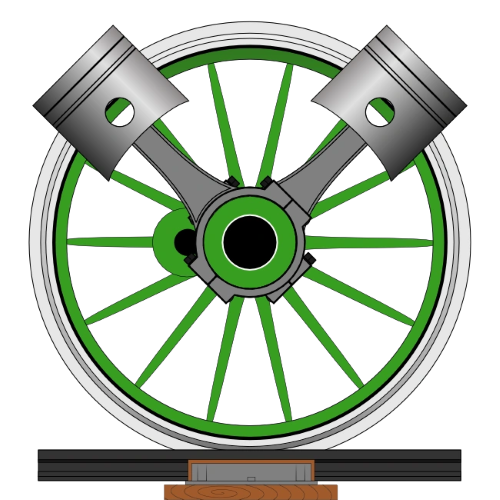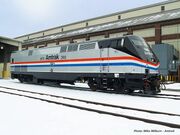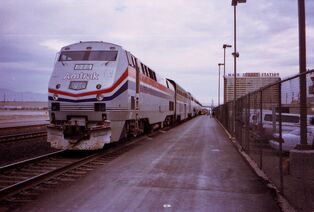
Amtrak P40DC (AMD-103) Genesis #832 in the Phase III paint scheme hauling the former Desert Wind passenger service in Las Vegas, Nevada in 1994.
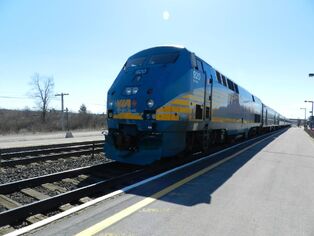
VIA Rail Canada's main Corridor locomotive, the P42DC
The General Electric (GE) Genesis Series (trademarked: GENESIS) is a series of 3,200hp to 4,200hp four-axle passenger diesel locomotives produced from 1992 to 2001.
They were primarily built and ordered from Amtrak, VIA Rail, and Metro-North. Many retired P40DC units from Amtrak have seen service on the New Jersey Transit (NJT) and the Connecticut department of Transportation (ConnDot)
History
In the late 1980s, Amtrak was looking for a new diesel locomotive; one with an extended range and being able to withstand the tight clearances of the Northeast, as well as being more fuel-efficient, lighter, and faster than the existing EMD F40PH. Two manufaturers, EMD and GE, responded. GE was ultimately awarded the contract to build an initial 64 diesel units and 10 dual-mode locomotives.
GE partnered with Krupp for the design of the lightweight bodyshell, however the final design wasn't able to be determined on time; GE would ultimately build 20 fewer units of the new design, and instead build 20 3,200hp units based on their existing line of four-axle Dash-8 freight locomotives. These locomotives are the P32-8WH units, and are currently in service as switchers and backup units.
The final design was finally revealed in 1993, as the "Genesis." Initially classed as AMD-103 (Amtrak Monocoque Diesel-103mph), these would later be re-designated as the P40DC. GE built 44 P40s for Amtrak. Today, some have been sold to commuter railroads such as NJ Transit and ConnDOT, while many have undergone refurbishment and reactivated by Amtrak (after being mothballed and stored in 2005.) Today most Amtrak P40's have been sold to the Connecticut Department of Transportation (ConnDot) and are frequently seen on Shore-Line-East Trains.
The second variant came 2 years later, as the AMD-110 dual-mode locomotive. While similar to the original P40DC on the outside, this locomotive had AC motors, capability to operate as a diesel locomotive and as an electric locomotive, and was geared for a maximum speed of 110mph. These were also later reclassed as the P32AC-DM.
Later on that year, the final variant was introduced; Amtrak requested an order for 120 diesel-powered units, but faster and more powerful than the P40DC. This came to be the P42DC, the primary locomotive for Amtrak outside the Northeast Corridor today.
Amtrak would return to GE to order 86 more P42DCs and 8 more dual-mode P32AC-DMs. Metro-North, a commuter railroad operating on the Empire Corridor in New York, ordered 32 P32AC-DM units for operating trains into New York's Grand Central Terminal. The final Genesis units produced by GE were 21 diesel units for VIA Rail of Canada, before the design was finally discontinued in 2001.
Design
A major part of the unique design of these diesel locomotives is their height. Designed to be lower than the EMD F40PH, the Genesis series is 14in (356mm) shorter. This makes the Genesis series the only Amtrak locomotives that can operate on all their lines in their system (even on electrified or third-rail lines like in the Northeast Corridor). Hence, they have also become the primary locomotive used for Amtrak.
To create the low-profile, streamlined shape; GE designed the GENESIS series o
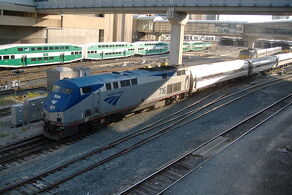
A modern Amtrak P32AC-DM seen at Toronto, Union Station.
f monocoque (or single-piece) construction. Its aerodynamics give it 22% more fuel efficiency, better crew safety (being classified as a "safety-cab" like with modern freight diesels) and it also produces 25% more power than the F40PH, which had a heavy hand in Amtrak's decision to replace the latter with this engine.
The down-side of having the single-piece construction is that it makes the locomotive more costly to repair in the event of a grade-crossing accident, causing Amtrak to install bolt-on nosecones on most units.
Specifications
The only differences between the versions of the Genesis Series locomotivesare the features and horsepower.
- P40DC (AMD-103) - 4,000hp.
- P42DC - Improved version of the P40DC; 4,200hp.
- P32AC-DM (Genesis II or AMD-110) - AC-traction motored 3,200hp unit capable of running off a 600V DC third rail system, via a drop-down third rail shoe.
Below are the specifications for the General Electric P42-8 (P42DC)
- Length: 69ft/21.03m
- Width: 10ft/3.05m
- Height: 14ft 4in/4.37m
- Weight: 121,928kg/268,800lb
- Wheel arrangement: B-B
- Bogies: Krupp/Siemens high speed
- Prime Mover: GE 7FDL-16
- Head-end-power delivery system: At-alternator
- Horsepower at-alternator: 4,250hp
- Horsepower at track, HEP mode: 3,550hp
- Can deliver HEP for up to 16 Amtrak Superliner coaches
- Maximum speed: 110mph/177km/h (VIA: 100mph/160km/h)
Spotting differences:
Although the Genesis series were all built virtually identical to each other, there are a few spotting differences;
- P40DC: This locomotive is nearly identical to the P42DC, although differences include:
- A Hostler's window at the rear of the locomotive (although it has been removed in recent Amtrak rebuilds)
- P32AC-DM: This locomotive has a number of differences compared to a P42DC.
- Additional equipment on the trucks, for third rail shoes.
- A quieter idle (due to its use of a static inverter for HEP generation, instead of the alternator-based design of the P40s and P42s)
- Taller, but shorter, radiator intake vents.
- Hostler's window similar to the P40DC
- No rear access door
- No bolt-on nosecone (unlike the DC units)
- There is still a shield above the main headlights (The DC units had them removed during their refurbish/rebuild)
- Headlight cluster is still in the shape of a "home-run plate" (unlike the DC units which had their headlights modified to look more rounded)
- Rear power outlets are placed lower than on the DC units
- A unique 3rd rail shoe that is used on Amtrak's empire corridor
Rebuilt and Upgraded P40DCs
By 2007, NJ Transit's P40DCs had been upgraded to P42DC standards (minus the speed difference). The conversion work from 4000hp to 4250hp was done by readjusting a lay shaft in the prime mover.
Amtrak later rebuilt 15 of its P40DCs like NJ Transit did (along with a re-gearing of the motors for 110mph service). They are now essentially P42DC units. All units that have been rebuilt have been returned to service. The only difference between these locomotives and actual P42DCs are that the upgraded P40DCs still feature mechanical air brakes.
Trivia
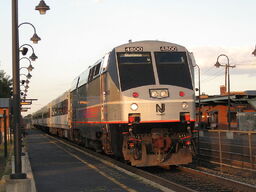
A NJT P40DC. (Notice how the front paint resembles large windows.)
- Despite the fact that the GE Genesis locomotives were primarily built for long-distance operations, VIA Rail uses these locomotives exclusively on its Quebec City-Windsor Corridor routes, where their additional speed and power is required to keep schedules.
- Several Latin American railroads have experimented with Genesis Series locomotives for passenger service, but for simplicity's sake they still prefer their original ALCO RS Series and EMD GP Series locomotives.
- The P32-8BWH (or B32-8BWH) was once also known as being part of the Genesis series because of its obvious name, and the Genesis series once being part of the Dash 8 series (as stated above). Yet, the P42DCs replaced the P32-8BWH, and the locomotive itself became a unique passenger variant of the B40-8W.
- Amtrak P42DC 32 was the final P42DC and final Genesis of all Genesis series to wear Amtrak's Phase 3 paint.
- The P42DCs were Amtrak's only Genesis units to wear Amtrak's Phase 5a paint.
- Amtrak has 4 original non-heritage Genesis paints: Phase 3, Phase 4, Phase 5a, and Phase 5b.
- During Amtrak's 40th anniversary celebration, 5 P40DC/P42DC Genesis units were painted in commemorative schemes to replicate Amtrak's previous schemes which were once used.
- One Amtrak P42DC, the AMTK 100, was painted in an exclusive US Postal Service scheme to commemorate the centennial and millennium events which occurred during 1999-2000.
- Amtrak P42DC 189 wears "The Heartland Flyer's Big Game Train" stickers on either side to promote the Oklahoma vs. Texas football game. The stickers were applied in 2013.
- Amtrak P40DCs 833, 834, 836, 838, and 840-843 were leased to Shore Line East and sold to the Connecticut Department Transportation in 2005 and are currently in service on most trains
- Amtrak P40DCs 808, 810, 812, and 820 were rebuilt with P42DC specifications at Beech Grove, IN and sold to New Jersey transit in 2007.
- Amtrak P40DCs 809, 814-818, 821-824, 830-832, 835, and 837 were rebuilt with P42DC specifications at Beech Grove, IN and returned to service between 2010 and 2011.
- Amtrak P-40-DC 801 on The Point of the Restored Floridian in 1982 was featured in "There Goes a Train."
- Amtrak #42 was painted in a special paint dedicating the US Military veterans service to the United States military (besides the number also serving as a commemoration to the railroad's 42 years of service).
- Ironically, Amtrak #42 was previously serving as a temporary replacement unit on Amtrak California's commuter service, and was filling-in for a P32-8BWH unit which was undergoing repairs and was being overhauled.
- Most of Amtrak's original P40DC (AMD-103) have since been converted and rebuilt into P42DC units with the exception of the few sold to the Connecticuit Department of Transportation and NJ Transit.
- Amtrak currently owns and operates 18 P32AC-DM units. They are numbered 700-717, and are exclusively used on services operating on the Empire Corridor between New York City and Albany.
- Several of the Metro North's P32AC-DM units were painted in a "heritage" scheme used to dedicate or commemorate the New Haven railroad which once operated over the MN's trackage (several of their former NH FL9 units were also painted back into their original scheme, while some still also retain their original, restored paintwork; besides rebuilt units such as their BL20-BH fleet and GP40PH-2 units).
- VIA Rail's P42DCs are classed EPA-42a (GE Passenger A-unit, 4250hp, first series [a]) by CN Rail.
- Most of VIA's P42DCs are equipped with the standard K5LA horn, as well as an additional "Canadian" K5LLA emergency horn. The oddball of the fleet is #917, which (along with its green paint) is equipped with a Nathan K3L horn instead of the usual K5LA.
Gallery
References
- Wikipedia.org
- Book: The Complete Book of Locomotives written by Colin Garratt, published by Hermes House. ISBN: 978-1-84477-022-9.
- Book: The Encylopedia of Trains And Locomotives, published by Barnes And Noble Publishing
